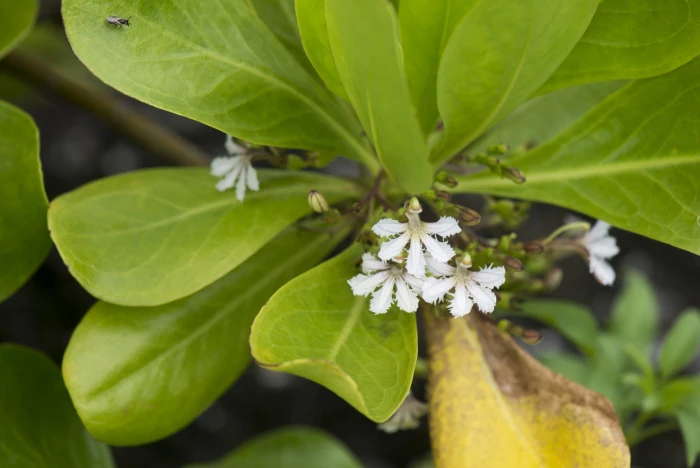Beach Naupaka
(Scaevola sericea)
Beach Naupaka (Scaevola sericea)
/
/

LiCheng Shih
CC BY 2.0
Image By:
LiCheng Shih
Recorded By:
Copyright:
CC BY 2.0
Copyright Notice:
Photo by: LiCheng Shih | License Type: CC BY 2.0 | License URL: https://creativecommons.org/licenses/by-sa/2.0/ | Uploader: papilioshih | Publisher: Flickr |















































Estimated Native Range
Climate Requirements for Geelong, Australia
| This Plant | Your Site | Plant Suitability for Your Location | ||
|---|---|---|---|---|
| • Precipitation | 4" - 362" | 22" | Your precipitation may be insufficient for this plant. Irrigate N" / year. | Irrigate N" / year |
| • High Temp. | 51°F - 107°F | 77°F | Your summer temperatures are normal for this plant. | Excellent |
| • Low Temp. | 3°F - 79°F | 43°F | Your winter temperatures are normal for this plant | Excellent |
This plant should grow well at your location with about N inches per year (Y minutes per month) of irrigation.
Summary
Scaevola sericea, commonly known as Beach Naupaka, is an evergreen shrub native to coastal areas, including beaches, coastal forests, and rocky shorelines in the Pacific and Indian Oceans, particularly in Australia, the Pacific Islands, and the coastlines of the Western Indian Ocean. It typically grows to a height of 3-10 feet (0.9-3 meters) and a width of 6-15 feet (1.8-4.6 meters). The plant has a sprawling habit with thick, fleshy leaves that are well-adapted to saline environments. Beach Naupaka produces distinctive half-flowers that are white to pale purple, giving the appearance of a flower torn in half. These blooms are present year-round in its native habitat and are quite showy, attracting pollinators such as bees and butterflies.
Beach Naupaka is valued for its tolerance of salt spray and sandy soils, making it an excellent choice for seaside gardens and coastal restoration projects. It is also used as a hedge or screen and for erosion control. In cultivation, it requires full sun to partial shade, regular to moderate watering, and well-draining soil. While it is generally low-maintenance, it can be susceptible to scale insects and mealybugs. Due to its potential invasiveness, it is crucial to consult local regulations before planting Beach Naupaka outside its native range.CC BY-SA 4.0
Beach Naupaka is valued for its tolerance of salt spray and sandy soils, making it an excellent choice for seaside gardens and coastal restoration projects. It is also used as a hedge or screen and for erosion control. In cultivation, it requires full sun to partial shade, regular to moderate watering, and well-draining soil. While it is generally low-maintenance, it can be susceptible to scale insects and mealybugs. Due to its potential invasiveness, it is crucial to consult local regulations before planting Beach Naupaka outside its native range.CC BY-SA 4.0
Plant Description
- Plant Type: Shrub
- Height: 3-10 feet
- Width: 6-15 feet
- Growth Rate: Moderate
- Flower Color: White
- Flowering Season: Spring, Summer
- Leaf Retention: Evergreen
Growth Requirements
- Sun: Full Sun
- Water: Medium
- Drainage: Medium
Common Uses
Bank Stabilization, Bird Garden, Drought Tolerant, Erosion Control, Fragrant, Groundcover, Salt Tolerant
Natural Habitat
Coastal areas, including beaches, coastal forests, and rocky shorelines in the Pacific and Indian Oceans
Other Names
Common Names: Beach Cabbage, Sea Lettuce, Naupaka Kahakai
Scientific Names: Scaevola sericea, Scaevola taccada, Scaevola frutescens, Scaveola plumieri, Scaevola taccada var. tuamotuensis, Scaevola taccada var. taccada, Scaevola koenigii, Scaevola taccada subsp. sericea, Scaevola taccada var. sericea
GBIF Accepted Name: Scaevola sericea G.Forst.